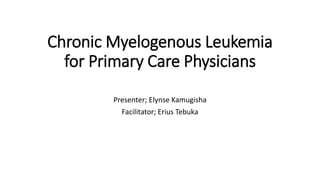This document provides an overview of chronic myelogenous leukemia (CML) for primary care physicians. It discusses the epidemiology, clinical manifestations, molecular pathophysiology, natural history, diagnosis, and treatment of CML. Key points include: CML represents 15-20% of adult leukemias, with the median age of onset being 45-55 years. The Philadelphia chromosome, resulting from a translocation, produces a Bcr-abl fusion gene that drives uncontrolled proliferation. CML progresses through chronic, accelerated, and blast phases if left untreated. Tyrosine kinase inhibitors like imatinib revolutionized treatment by targeting the Bcr-abl protein. Imatinib induces high rates of remission but side effects can include





























